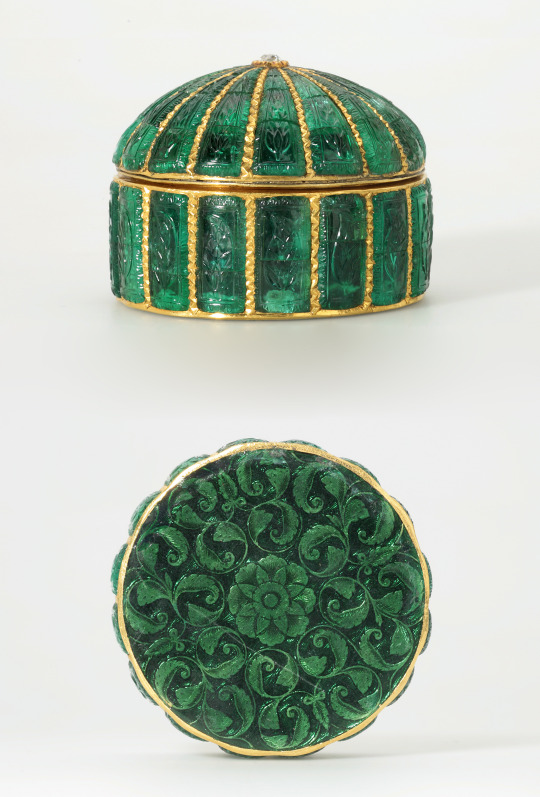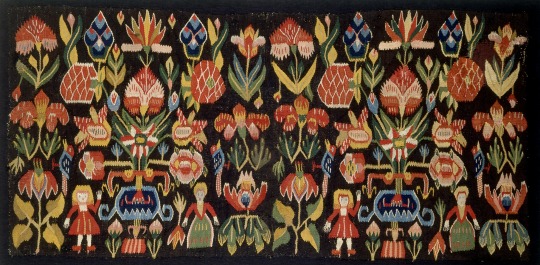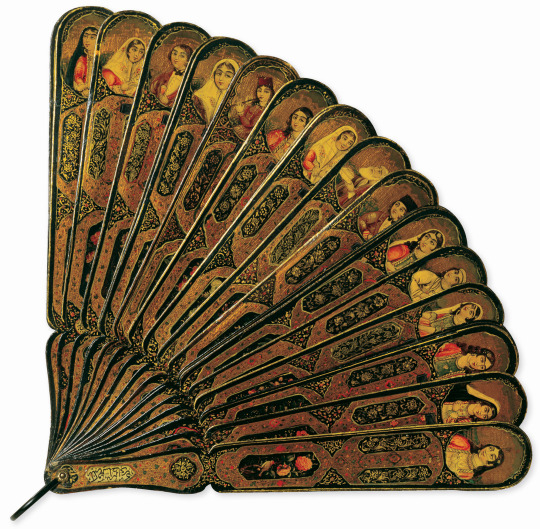#Khalili Collections
Explore tagged Tumblr posts
Text
#InternationalPolarBearDay:

Vase In The Form Of Two #PolarBears Inside An Icy Cave 'Makuzu' ware, Miyagawa Kozan workshop,Yokohama, Japan, c.1900-10 porcelain with decoration in underglaze turquoise & brown, H 22.2 cm x D 15.9 cm Victoria and Albert Museum C.244-1910: https://collections.vam.ac.uk/item/O39341/vase-miyagawa-kozan/ "From the late 19th century, the Makuzu workshop produced porcelain for the Western market. The source of inspiration for this remarkable object was models of polar bears made by the Royal Copenhagen Manufactory. The icy effect was created using experimental glaze techniques."
PS: there is a similar, slightly larger piece in the Khalili Collections:

#animals in art#animal holiday#20th century art#Japanese art#East Asian art#Asian art#porcelain#vase#ceramics#polar bear#polar bears#bear#bears#International Polar Bear Day#Makuzu ware#Miyagawa Kozan#Victoria and Albert Museum#Khalili Collections#1900s
125 notes
·
View notes
Text

Sculpture (carved and painted limestone) of a crowned head, made by an unknown Central Asian artist between 700 and 900. Now in the Nasser D. Khalili Collection of Islamic Art. Photo credit: Khalili Collections / CC-BY-SA 3.0 IGO.
#art#art history#sculpture#portrait sculpture#Central Asia#Central Asian art#Islamic art#stonework#limestone#Nasser D. Khalili Collection of Islamic Art
94 notes
·
View notes
Text

Incense Burner in the Form of a Dove. Iran. Seljuk Period. 12th Century CE.
The Khalili Collections.
#art#culture#history#middle eastern history#turkic#medieval#seljuk empire#seljuk#the khalili collections#middle ages#animals in art#animals#birds#medieval history
13 notes
·
View notes
Text

Chemise talismanique en coton sur laquelle sont inscrits des versets coraniques, des prières et des invocations à Dieu, terres ottomanes, XVII e siècle. Les Collections Khalili, TXT 545 .
4 notes
·
View notes
Photo
Pair of Vases (right of a pair)


Pair of Vases (Both)

Enamel vase. Tokyo, Japan. circa 1883. Cloisonné enamel, gilt metal wire, silver wire, shosen jippo, applied with gilt metal mounts. height 55.2 cm. A pair of Cloisonné enamel vases with a design in the style of Nishi Chinnen (1792-1851), each decorated with butterflies above flowers and grasses on a pale grey ground. The flowers include peonies, Chinese bell-flowers, and susuki, and the butterflies are varaities of whites. The peony-leaves and some of the flowers worked in gilt metal wire, the others in silver wire, each with extensive shading; some of the smaller flowers of partially wire-less outline (shosen jippo). The upper border worked in silver wire with numerous stylized dragonflies of various sizes, on a black ground. The foot decorated with a border of stylized pinks beneath scattered foliage and berries, also on a black ground. Applied with gilt metal mounts.
These vases, demonstrably the work of Namikawa Sosuke, were exhibited at the Amsterdam Exhibition of 1883 at which Sosuke and the Nagoya Cloisonné Company were awarded the first-class gold medal and where the President of the Company, Mr Muramatsu, was decorated by the King of Holland. Text and image via Khalili Collection
#enamel vase#cloisonné enamel#搪瓷花瓶#景泰藍琺瑯#design in the style of nishi chinnen#namikawa sosuke#濤川惣助 (なみかわそうすけ)#1847-1910 japanese#“golden age” of japanese enamels#one of the most famous cloisonné artists during 1890-1910 period#khalili collection#meiji art E019L#美
2K notes
·
View notes
Text

Emerald set box, Mughal Empire (India), circa 1635
from The Khalili Collection
5K notes
·
View notes
Text


Skånsk textiles, late 18th century
from the Khalili Collections
3K notes
·
View notes
Text

Folding fan, Iran, circa 1870
from The Khalili Collection
3K notes
·
View notes
Text

The Qajar Ruler, Fath 'Ali Shah Baqir (active early 19th C) The Khalili Collections
74 notes
·
View notes
Text
Brands that support Palestine/ Palestinian brand products 🇵🇸
Paliroots
KUVRD
West Bank Apparel
PurePali
West Bank Hoodie
PALIDRIP
Hirbawi
Anat International
Deerah
Nol Collective
Watan
MeeraAdan
Holy Land Boutique
Nnbynn
Ayadi
Balady Stich
Nadine Khalili Jewelry
Sunbula
ElBustan
Fyrouzi
FalastiniBrand
Dar Collective
Handmade Palestine
Darzah designs
Haute Hijab
Huda Beauty
Rising Cane's
Tatcha
136 notes
·
View notes
Text

Pendant in the Form of an Eagle Displayed
Deccan or Southern India, early 17th c.
Gold set with foiled diamonds, rubies, emeralds, & sapphires in gold kundan & wired pearls
8.5 x 6.5cm
The Khalili Collections JLY 2151
#animals in art#birds in art#bird#Indian art#Asian art#South Asian Art#The Khalili Collections#17th Century art#jewelry#gold#gemstone jewlelry#gemstones#eagle#metalwork
44 notes
·
View notes
Photo

Circa 1968 Aloisia Rucellai evening bag, gold and platinum, translucent enamel, diamonds, and rubies.
17 notes
·
View notes
Text

"Waves" maki-e panel, 1888-1890, the Khalili Collection of Japanese Art
Shibata Zeshin
13 notes
·
View notes
Text

Title: Pilgrimage Certificate of Hajj ‘Abbas Kararah
Date: 1930 or earlier
Khalili Collections | Home
Location: Egypt
7 notes
·
View notes
Text
Reading List - 2024
Let's Do It, Already!, Vol. 1 - Aki Kusaka
House of Hunger - Alexis Henderson
A Fragile Enchantment - Allison Saft
Honey So Sweet, Vol. 1-5 - Amu Meguro
In the Roses of Pieria - Anna Burke
The Toymaker's Son - Ariana Nash
Kitchen - Banana Yoshimoto
Hardboiled & Hard Luck - Banana Yoshimoto
Your Utopia - Bora Chung
Don't Beat Your Children or They'll Turn Out Like Me - Brad "BLUE" Bathgate
Slewfoot: A Tale of Bewitchery - Brom
St. Valentine, St. Abigail, St. Brigid - C.L. Polk
Clockwork Prince - Cassandra Clare
One Saved to the Sea - Catt Kingsgrave
She Came From the Swamp - Darva Green
Vertigo Peaks - Dion Anja
O Caledonia - Elspeth Barker
Cair - Eryn Hawk
Teighan - Eryn Hawk
All That's Left to You - Ghassan Kanafani
The Hanging Game - Helen Marshall
Vampire Hunter D, Vol. 1 [Dramatized Adaption] - Hideyuki Kikuchi
The Queen of Nothing - Holly Black
The Stolen Heir - Holly Black
Welcome to the Hyunam-Dong Bookshop - Hwang Bo-Reum
Honeybloods - I.S. Belle
Love Bullet, Vol. 1 - Inee
Vampires of El Norte - Isabel Canas
A Cup of Salt Tears - Isabel Yap
Paradise Rot - Jenny Hval
Kamisama Kiss, Vol. 4-7 - Julietta Suzuki
The Case Study of Vanitas, Vol. 1 - Jun Mochizuki
Be Very Afraid of Kanako Inuki! - Kamako Inuki
God Save the Queen - Kate Locke
The Queen is Dead - Kate Locke
Long Live the Queen - Kate Locke
The Demon's Bargain - Katee Robert
The Gargoyle's Captive - Katee Robert
The Sucubus' Bride - Katee Robert
Her Frankenstein - Kawashima Norikazu
A Bone in His Teeth - Kellen Graves
Prince of the Sorrows - Kellen Graves
Lord of Silver Ashes - Kellen Graves
Herald of the Witch's Mark - Kellen Graves
The Fox and the Dryad - Kellen Graves
A Human Stain - Kelly Robson
Triquetra - Kirstyn McDermott
Soul Eater - Lily Mayne
Edin - Lily Mayne
The Rycke - Lily Mayne
Gloam - Lily Mayne
Wyn - Lily Mayne
Moth - Lily Mayne
Seraph - Lily Mayne
Lor - Lily Mayne
A Collection of Monstrous Stories - Lily Mayne
A Monstrous Christmas in the Camp - Lily Mayne
Mortal Skin - Lily Mayne
Forgotten Vows - Lily Mayne
King of Death - Lily Mayne
Born of Blood and Magic - M.C. Hutson
All Systems Red - Martha Wells
Artificial Condition - Martha Wells
Rogue Protocol - Martha Wells
Exit Strategy - Martha Wells
Fugitive Telemetry - Martha Wells
Network Effect - Martha Wells
System Collapse - Martha Wells
This is How You Lose the Time War - Max Gladstone, Amal El-Mohar
The Dragon's Betrothed, Vol. 1-2 - Meguru Hinohara
The Girl That Can't Get A Girlfriend - Mieri Hiranishi
My Special One, Vol. 1 - Momoko Koda
Crypt of the Moon Spider - Nathan Ballingrud
Lights Out - Navessa Allen
Binti - Nnedi Okorafor
Softening - Olivia Braley
The Angel of Khan el-Khalili - P. Djeli Clark
Glamour - Penelope Fletcher
Coil of Boughs - Penny Moss
House of Glass - Rojana Krait
Kappa - Ryunosuko Akutagawa
Carmilla and Laura - S.D. Simper
Burning Roses - S.L. Huang
Old Fashioned Cupcake - Sagan Sagan
Old Fashioned Cupcake with Cappuccino - Sagan Sagan
A Court of Thorns and Roses (2 of 2) [Dramatized Adaption] - Sarah J Mass
A Court of Silver Flames (1 of 2) [Dramatized Adaption] - Sarah J Mass
A Court of Silver Flames (2 of 2) [Dramatized Adaption] - Sarah J Mass
Pink Heart Jam, Vol. 1-2 - Shikke
Certain Dark Things - Silvia Moreno-Garcia
The Rot - Siri Pettersen
An Education in Malice - S.T. Gibson
The Guy She Was Interested In Wasn't A Guy At All, Vol. 1-2 - Rumiko Arai
Stuffed - Sylvia Morrow
Thornhedge - T. Kingfisher
A Wolf Steps in Blood - Tamara Jeree
Gideon the Ninth - Tamsyn Muir (x2)
The Necromancer's Light - Tavia Lark
The Paladin's Shadow
The Sword-Witch's Heart
Wolfsong - T.J. Klune
Heartsong - T.J. Klune
Midnight Secretary, Vol. 1 - Tomu Ohmi
Unhinged - Vera Valentine
The Healing Season of Pottery - Yeon Somin
Mr. Villain's Day Off, Vol. 1-3 - You Morikawa
Alice 19th, Vol. 3 - Yuu Watase
2 notes
·
View notes
Text
6/14/24 LinkedIn - from Rui Galopim de Carvalho
Gem quality emeralds are known to typically display internal characteristics, such as those known in gemmology as fluid inclusions and fissures, sometimes in such a quantity that it may compromise the stone's "crystalline" transparency, making polishing as bead, as cabochon or carving as an adequate options in fashioning. Colombian emeralds, such as those produced in the 16th and 17th century, were often carved with artistic or devotional motifs, in both low and high clarity rough material. This ca. 1635 green box (4 x 5 cm) made in Mughal India using gold sheet, set with faceted diamond in gold kundan, with an enamelled base, is set with 103 matched Colombian emeralds carved in shallow relief to depict cypress trees within borders of repeated stylized leaves, is a fine example of this fashioning solution. At the highest levels of the Mughal courts, a considerable number of carved emeralds were commissioned and this is believed to be one of those cases. Photos © Khalili Collections


can you believe it!? fantastic!!!
3 notes
·
View notes